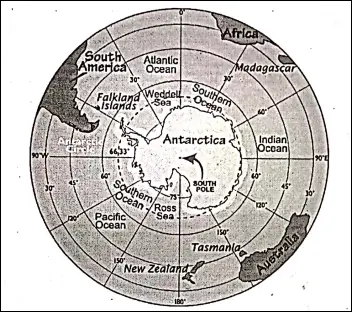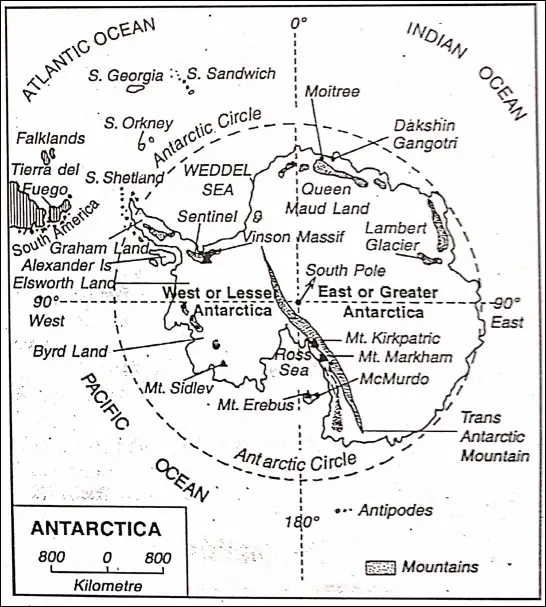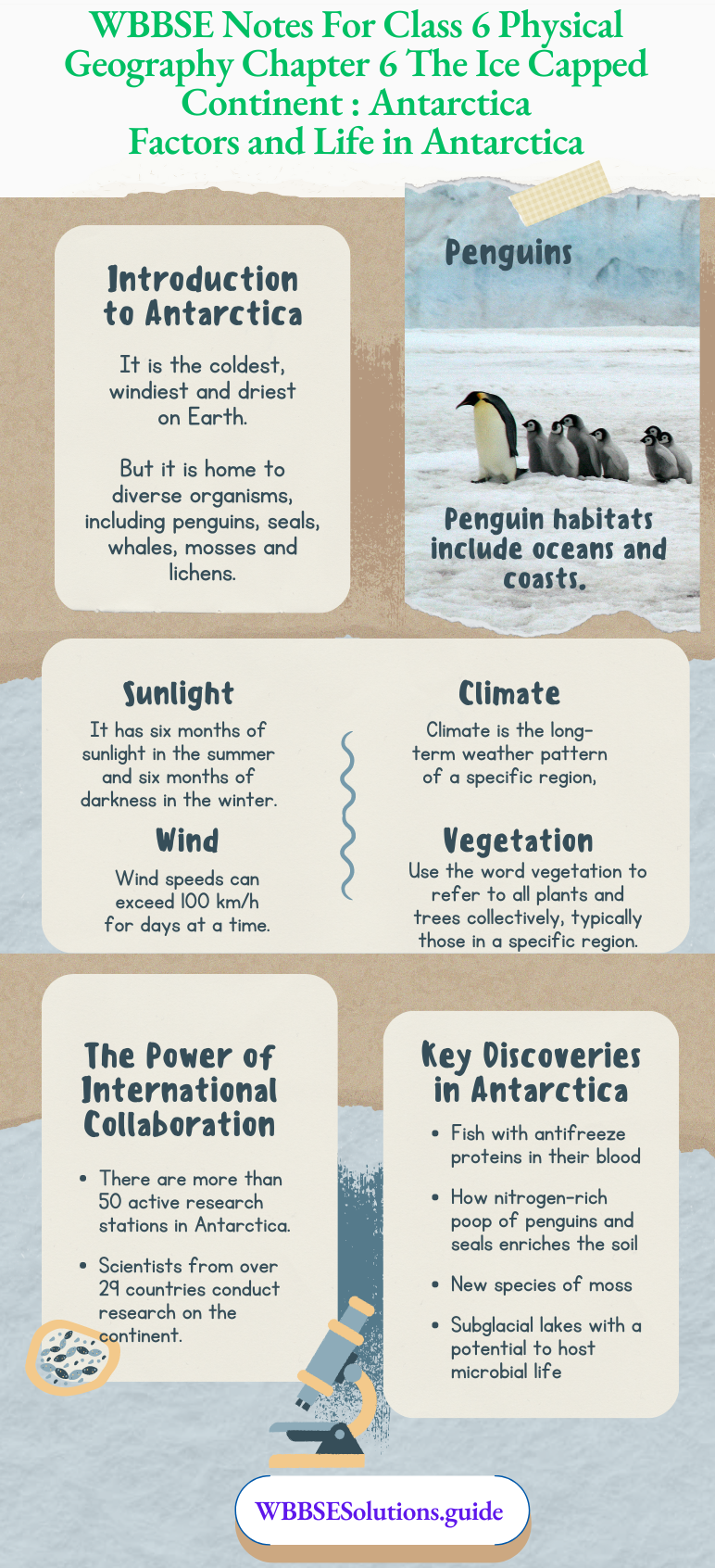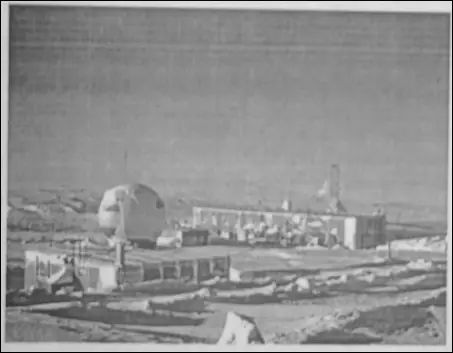Chapter 6 The Ice-Capped Continent: Antarctica Introduction :
The Ice-Capped Continent:
The great ice-capped southern continent situated in frigid isolation around the South Pole is called Antarctica. It is the most desolate continent of the world.
The continent is deeply covered with ice, the average thickness being 1800 metres. The thickness increases with the distance from the sea and the maximum depth measured is 4200 metres.
The ice constitutes 90% of the world’s ice and 70% of the world’s freshwater reserve, and its melting would cause the oceans to rise by 60 metres. The ice gradually moves outwards from the centre as glaciers.

Notable among these are Lambert and Beardmore. Antarctica is described as a large round ice cake with two roughly triangular pieces cut from it—the Weddell sea and the Ross Sea in West Antarctica.
Antarctica is thought to have been once a part of a single great landmass called Gondwanaland (The southern part of Pangaea includes Antarctica, Africa/South America, Australia and India).
Read and Learn More WBBSE Notes For Class 6 Junior School Geography
About 200 million years ago Gondwanaland began to break up and Antarctica drifted towards the South Pole. A man came to know about this continent in 1820.
Location Of Antarctica :
Antarctica lies around the geographical South Pole (90°S) beyond the latitude of Antarctica circle (66°30’C). In winter, it extends up to 60° south latitude, became the sea around this continent freezes and the limit of Antarctica is extended.
| Class 6 History | Class 6 Social Science |
| Class 6 Geography | Class 6 Science |
| Class 6 Maths | Class 6 Science MCQs |
| Class 6 General Science | Class 6 Maths Solutions |
| Class 6 Geography | Class 6 Hindi |
Boundary Of Antarctica :
This roughly circular continent is placed between the South Pole and the 60°S parallel of latitude. It is circumscribed by an Antarctic circle and surrounded by the Antarctic ocean. Many seas, bays and groups of islands surround the continent (Ross Bay, Pacific Ocean etc.)
Area and Extension :
Antarctica covers an area of 1 crore 40 lakh square kilometres. This is. the fifth largest continent of the world after Asia, Africa, North America and South America. Europe is sixth and Oceania seventh.
Geographical Importance :
Antarctica is the fifth largest continent or the world. It has very much geographical significance as follows :
- Antarctica is the Earth’s highest, coldest, driest, windiest and remotest continent.
- The continent has about 90% of the world’s ice. If all of this ice is melted sea levels would rise about 60 metres.
- A sheet of ice averaging at least 1-6 km thick covers the continent.
- As the continent is covered entirely by the snow and ice, it looks white. So, it is also called the ‘white continent’.
- The continent has many large glaciers. Lambert glacier is the longest glacier on the Earth.
Physical Features Of Antarctica :
Relief:
Actually, Antarctica is a plateau of ancient landmass. Below the ice sheet, the surface of Antarctica is undulating. The average height of the plateau is 1800 metres.
The continent has an extremely long, (29800 km) and indented coastline and is between 2000 and 2400 metres high. On account of its high elevation, it is regarded as the highest content of the world.
“WBBSE class 6 physical geography chapter 6 notes”
The 2400 km long Trans-Antarctica Mountain divide the continent into two part: East Antarctica and West Antarctica. East Antarctica is a vast plateau and 600 million years old, as ancient as the Canadian shield.
West Antarctica, with its high mountain peaks, volcanos, capped plains and many island groups is much more recent in or *’ n. The Peninsula of Grahamiand of West Antarctica is in fact, a range that continues from the Andes.

I the submerged portion of this mountain is called Scotia Range’ It rises above the sea level forming Islands like the Tlerre-del-Fuego, South Georgia, South Sandwich, South Orkney and South Shetland.
The Trans-Antarctka Mountains form the continental backbone with peaks as high as 4800 metres Mt. Vtncum or Vinson (5140 m) on the Sentinel Range in north-west Graham’s land is the highest peak of Antarctica.
“the ice-capped continent Antarctica WBBSE class 6 notes”
There are many active volcanoes and most of these are found in West Antarctica. Mt. Erebus (3794 m) on Ross island is an active volcano. Many large glaciers are also found In Antarctica Lambert (400 km long and 64 km wide) is the longest glacier of the world.

Climate :
Antarctica is the coldest, driest and windiest of all the continents. It is nearly always frozen and the air is dry.
Winds reach gale force (200 km/hour) and frequent blizzards (snow-storms) occur in Autumn and winter Near the coast, the average temperature varies between 0° and – 11°C while tin* interior plateau records temperatures as low as – 88°C.
Russia’s Vostok’s research station m Queen Maud Land recorded a temperature of – 89 2° C in July 1983 which is the lowest temperature ever recorded anywhere in the world.

During the long winter, the land remains in darkness for months together. But in summer, the Sun with its most oblique rays bathes the continent in continuous daylight.
“summary of class 6 physical geography chapter 6 WBBSE”
So, around the South Pole, 6 months day and 6 months night prevail. When the Sun is seen nowhere in the sky, the celestial play of lights of various colours throughout the sky often observed during this time is called the Aurora’ (Aurora Australis).
In the summer, temperature rises to – 20°C. The sun never sets but the sunlight is oblique and a good part of it is reflected by the ice. So, the temperature does not increase too much.
Vegetation
The climate of Antarctica is not conducive to the growth of vegetation. Freezing temperature, poor soil quality, and lack of sunlight and moisture inhibit plant growth.
There is not a single tree or a bush in this bleak land with its dazzling mantle of ice. Only during summer when some ice melts, mosses, fungi and lichens grow in the coastal areas. There are about 100 species of mosses in Antarctica.
Animals/Living Creatures
Antarctica is the permanent home of the Penguins. There are also different migrating birds like the gulls, skua, terns, and petrels are found in the coastal areas in summer.
Living creatures include many species of fish, whales and seals are also found in the sea. Antarctica waters also abound in ‘krill’ (krill is the name given to small red shrimps) and microscopic one-celled plants called diatoms.
“important questions from Antarctica class 6 geography”
While krills are eaten by seals, whales and Penguins, diatoms form food for fish.

Penguins
The Penguins are flightless aquatic birds who can swim well. Antarctica is the home of Penguins. They are the permanent residents of this continent. Some penguins are found in the coastal areas.
There are 17 different species of penguins in Antarctica. The Emperor penguins are the largest among them. They are almost four feet tall, an adult weighs almost 30 kg.
“WBBSE class 6 geography chapter 6 key points”
Their bodies are entirely covered with glossy feathers that never get wet. A thick layer of fat under their skins saves them from the biting cold. They feed mainly on small marine organisms, fish and Krill (small red shrimps).
Mineral Resources :
The continent seems to be a storehouse of minerals. But mining is difficult and costly. According to the geologists, there are possibilities of obtaining some important minerals, namely
- Iron ore
- Coal
- Copper ore
- Gold
- Mineral oil
- Natural gas and others
Expedition To The South Pole
Several expeditions were made to discover the continent of Antarctica. The expedition in the south began in the 16th century after the discovery of America by Christopher Columbus.
But the systematic expedition to the south pole started in 1772 when Captain James Cook reached for the first time near Antarctica with his ship evading ‘Pack ice’ and iceberg.
The first landing on Antarctica was by John Davis in West Antarctica in 1821. In 1841, James Clark Ross passed through the ‘Ross Sea’ and discovered the ‘Ross Island’.
In 1907, Ernest Shackleton became the first to reach the South Magnetic Pole and to climb Mt. Erebus. An expedition team led by Norwegian Polar explorer Roald Amundsen became the first to reach the ‘Geographic South Pole’ or the central point of Antarctica, (i.e. the 90°S) on 14th December 1911.
“climate and weather conditions in Antarctica class 6”
The team left the base camp on 19th October 1911. They had to overcome great adversities like blizzards, deep crevasses etc. to reach the ‘South Pole’ on the Earth.
It should be noted that Captain Scott who had actually reached Antarctica before Amundsen but was delayed for his research work there, reached the ‘Geographical South Pole’ on 17th January 1912.
He found a note, left by Amundsen and a flag of Norway. Captain Scott started his return journey but he could not return; with a broken heart he died in the domain of snow.
Indian Expeditions To Antarctica
Our country India has carried many expeditions to Antarctica. The first team of Indian explorers reached Antarctica on 9th January 1982.
They established the first Indian research centre in Antarctica which was named ‘Dakshin Gangotri’ (70°S, 12°E). In 1989 another research station ‘Moitree’ (70°45’S, 11°44’E) was established at 70 km.
“why is Antarctica called the ice-capped continent”
Away from the Dakshin Gangotri on 26th March 1988, by the eighth team of explorers from India. The 19th Jndian expedition returned from Antarctica in March 2000. India is planning to set up her third permanent research station very soon.
Antarctic Treaty :
The Antarctic Treaty signed in 1959 by 12 countries has now got 49 members all over the world including India. By this treaty mineral mining, military activities, nuclear explosions etc. Are prohibited in this continent. Only scientific research can be conducted by the nations in order to maintain the ecological balance.
Antarctica :
The Continent Of Science
Antarctica is not the territory of any country, it is an international land open to all the nations of the world. It has attracted the attention of scientists in recent years.
U.K., Norway, Sweden, France, Belgium, Germany, New Zealand, the U.S.A, Russia, Argentina, Brazil and India have established their permanent research stations in Antarctica.
“human activities and research stations in Antarctica”
Atmospheric, biological, Earth, chemical and medical sciences are studied by these research stations. The scientists from different nations carry out research work on the environment, geology, mineral resources, weather and climate etc.
Antarctica is a continent dedicated to peace and science. The world nations are trying for Cooperative scientific exploration for the well being of human generations. So, it is rightly known as the ‘continent of science’.
Transport :
Transport in this roadless continent consists of sledges drawn by teams of dog called ‘huskies’ or by tracked vehicles, helicopters and aircraft.
Population :
In this desolate land, the population which is composed of the personnel of different scientific stations averages 900 in winter. But it rises to about 11000 in summer with the arrival of the temporary visitors, tourists and personnel in the summer research sites.
The Future Of Antarctica
Antarctica has an ecological balance in the natural environment. To maintain this balance, Antarctica is protected from fishing and mineral exploitation.
However, as energy and mineral reserves and fishing resources get exhausted or depleted In other parts of the world, we may look forward to Antarctica for these resources.
So the pressure to exploit the natural resources of Antarctica from the land and in the ocean Is likely to increase jn future. This increase may have an impact on the natural environment of Antarctica.
“flora and fauna of Antarctica WBBSE class 6 notes”
Global warming, depletion of the ozone layer and air pollution etc. have posed a serious threat to the future of this continent. The ice cap in Antarctica is melting every day due to the rise of temperature.
It reduces the geographical expanse of Antarctica and causes an alarming rise of the sea level. All these may have an adverse effect on the living world and the natural environment of Antarctica.
Krills, seals, whales and penguins are dying thereby jeopardizing the natural balance of the Antarctic environment. So, the future of Antarctica is not beyond doubt.
WBBSE Notes for Class 6 Junior School Geography
- Chapter 1 The Universe and Solar System
- Chapter 2 Shape of The Earth: Is The Earth Around?
- Chapter 3 Location of a Place on The Earth’ Surface: Where You Are
- Chapter 4 The Earth’s Motion: The Earth Rotation
- Chapter 5 Water – Land – Air
- Chapter 6 The Ice Capped Continent: Antartica
- Chapter 7 Weather And Climate
- Chapter 8 Air Pollution
- Chapter 9 Noise Pollution
- Chapter 10 India
- Chapter 11 – Maps
